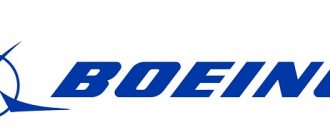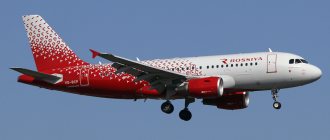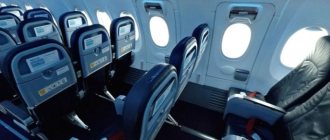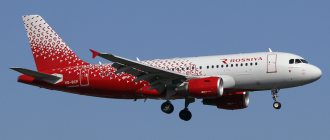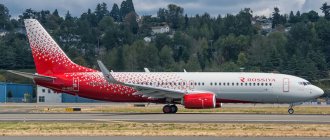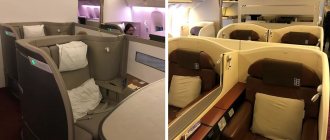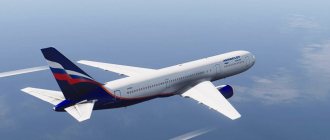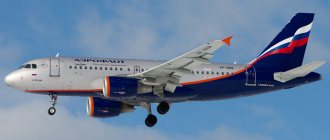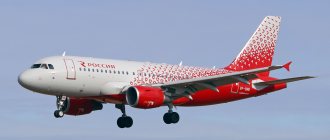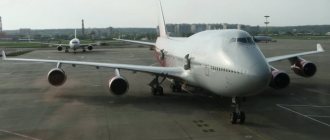Boeing 737 is one of the most famous and operated narrow-body aircraft series. The Boeing company has been on the market since 1967 and to this day maintains a leading position: in 2014, the company announced that it had produced its anniversary 8,000th airliner. The largest operator of Boeings of different generations is the American airline Southwest Airlines . Its aircraft fleet includes a total of 684 Boeings .
Boeing 737-700 aircraft from the Next Generation series of Southwest Airlines
Boeing 737 is not an aircraft model, but the name of an entire “family”, which includes 3+1 series:
- Original;
- Classic;
- NG (Next Generation);
- Max.
Boeing 737 modifications
Over the long history of the airliner, several modifications of the aircraft, belonging to four generations, have been developed and produced.
| Modification | Year of issue | Flight range, km | Number of passengers, people | Generation |
| Boeing 737-100 | 1967 | 2592 | 103 | Original |
| Boeing 737-200 | 1967 | 3518 | 133 | Original |
| Boeing 737-300 | 1984 | 5000 | 149 | Classic |
| Boeing 737-400 | 1988 | 5000 | 168 | Classic |
| Boeing 737-500 | 1990 | 5200 | 132 | Classic |
| Boeing 737-600 | 1998 | 5648 | 130 | New Generation |
| Boeing 737-700/700ER | 1997 | 6230 | 148 | New Generation |
| Boeing 737-800 | 1998 | 5765 | 189 | New Generation |
| Boeing 737-900 | 2001 | 5800 | 189 | New Generation |
| Boeing 737-900ER | 2007 | 5925 | 215 | New Generation |
| Boeing 737 MAX −7/8/9 | 2016 | 7038/6704/6658 | maximum −140/200/220 | MAX |
Original
The first generation Boeing 737 airliners did not gain much commercial success, as they consumed a lot of fuel, were noisy and expensive to maintain. The last 737-100 aircraft has ceased operation since 2007, and the 737-200 is still used by air carriers in African countries and some other countries.
On the basis of the Boeing 737-200, cargo and cargo-passenger variants were created, and the 737-200 Executive Jet was produced for private owners.
Interesting! Before the Boeing 737 was released, the passenger plane was piloted by 3 people, including a flight engineer. Here, for the first time, a cabin with two pilots was used, which became a revolutionary solution and was adopted as the basis for all subsequent models of passenger airliners.
Classic
Despite all the improvements in the Original generation aircraft, they began to lose significantly to their competitors. The new model has been developed with significant changes. The aircraft received new engines, the fuselage became longer, and the number of passengers carried increased. The aerodynamics have changed, the airliner has been equipped with new digital avionics (on-board electronic systems).
The 737-400 model, due to the enlarged cabin, has changed the internal air conditioning system and added a second pair of emergency exits in the wing area.
The 737-500 version has a shorter fuselage, less capacity, but a longer range.
New Generation
The new generation Boeing 737 has been redesigned even more radically. The wingspan has not only grown, but their geometry has also changed. Amendments were made to the tail unit. The passenger cabins of the New Generation aircraft and the Boeing 757, 767 have a lot in common, since the design of the Boeing 737's interior space was based on the design developments for these airliners.
Each subsequent version of the New Generation has a greater length with an almost unchanged fuselage diameter, and the engines of the latest modification 737-900ER, thanks to the improved wing design, consume less fuel at cruising speed.
Interesting! Based on the Boeing 737-700, 737-800 and 737-900, BBJ, BBJ2 BBJ3 (Boeing Business Jet) are produced, which are the most popular in the world among private clients. On board, at the request of the customer, a bedroom, shower room (bathtub), room for business meetings, etc. are arranged.
How does a jet engine work?
It is powered by jet thrust. This requires some kind of fluid to be pushed out from the back of the system and give it forward motion. Newton's third law works here , which states: “Every action causes an equal and opposite reaction.”
A jet engine uses air instead of liquid . It creates the force that provides movement.
It uses hot gases and a mixture of air and combustible fuel. This mixture comes out at high speed and pushes the plane forward, allowing it to fly.
If we talk about the design of a jet engine, it is a combination of four most important parts:
The compressor consists of several turbines that draw in air and compress it as it passes through angled blades. When compressed, the temperature and pressure of the air increase. Part of the compressed air enters the combustion chamber, where it is mixed with fuel and ignited. This increases the thermal energy of the air.
The hot mixture leaves the chamber at high speed and expands. There it passes through another turbine with blades that rotate thanks to the energy of the gas.
Business Class
Business class has soft, comfortable seats with a wide recline angle. The location of seats in most layout options is according to the 2-2 scheme. In total, there are from 2 to 5 rows in the bow cabin. Most often - 4 rows.
At the front of the aircraft, in front of the seats, there is a kitchen for luxury cabin clients and restrooms. The most relaxing places are the 2nd and 3rd row seats. The 1st and 4th row seats may not seem as comfortable due to the presence of nearby toilets, a kitchen and, in the case of the last row, the more crowded economy class. On some airlines, economy class is separated only by a curtain.
Operating principle of a turbojet engine
Unlike the jet engine, which is in demand for almost all aircraft, the turbojet engine is more suitable for passenger airliners. Because to operate a jet engine, you need not only fuel, but also an oxidizer.
Due to its structure, the oxidizer is supplied along with the fuel from the tank. And in cases with turbojet engines, oxidize, it comes directly from the atmosphere. Otherwise, their work is completely identical and does not differ from each other.
The main part of a turbojet engine is the turbine blade, since the engine power directly depends on its proper operation. Thanks to these blades, thrust is generated, which is necessary to maintain the speed of the aircraft. If you compare one blade to a car engine, it can provide power to as many as ten cars.
Economy class
In almost all economy class cabins, the seats are arranged in a 3-3 pattern. There are luggage racks on top. The restrooms and kitchen are located at the rear of the plane.
All airlines consider the most comfortable seats on the Boeing 737 to be the first row, right behind business class. It provides more legroom. Often tickets for this row are more expensive or sold to bonus card holders.
Inside the cabin, in the middle part, there is one paired emergency exit or two, depending on the version of the aircraft. Seats near emergency exits also have an increased distance between seats, but passengers may be uncomfortable with the rigid fixation of the seat backs and the side bulges on the side of the aircraft. But the seats immediately behind the emergency exits recline completely and have expanded space. The numbering of rows is confirmed with the carrier.
Important: The worst seats are in the last row of the aircraft. The proximity of the bathrooms and kitchen creates bustle and noise, and the seat backs do not recline or recline slightly.
What is a nuclear powered aircraft?
During the Cold War, attempts were made to create a jet engine not using a chemical reaction, but using the heat that would be generated by a nuclear reactor. It was installed instead of a combustion chamber.
Air passes through the reactor core, lowering its temperature and increasing its own. It expands and flows out of the nozzle at a speed greater than flight speed.
Combined turbojet-nuclear engine.
In the USSR, it was tested on the basis of the TU-95. The United States also did not lag behind scientists in the Soviet Union.
In the 60s, research on both sides gradually ceased. The main three problems that prevented development were:
- safety of pilots during flight;
- release of radioactive particles into the atmosphere;
- in the event of a plane crash, the radioactive reactor could explode, causing irreparable harm to all living things.
Design features and benefits
Each aircraft component has its own characteristic features and associated advantages:
- The design of the airliner is a monoplane with two engines placed on pylons and swept wings.
- The three-wheel chassis has a front swivel strut. The main support is not closed by the doors after folding is completed. This can be seen by the visible wheels. This solution simplified the design and reduced the weight of the aircraft, but somewhat worsened the aerodynamics.
- Since the engines are located low, it was necessary to slightly reduce their vertical dimensions. To do this, part of the lower equipment for the engine was placed on the sides and the air intake was slightly extended horizontally. The engines have a flattened shape, especially noticeable in the latest versions.
- The winglets (tips) on the wings underwent changes during the evolution of the Boeing 737. At first, minimal-sized winglets were made on the 737-200 modification. Subsequent generations, Classic and New Generation, received the large winglets that are now widespread. MAX generation aircraft use double winglets.
Interesting: Fuel consumption is reduced by 3.3% when using large winglets and by 5.5% when using double winglets.
- The Messier-Bugatti company equipped the airliner with carbon brakes in 2008. This made it possible to reduce weight by 320 kg and reduce fuel consumption by about half a percent.
- The cockpit, with seating for two pilots, originally had analogue devices and instruments. Now all aircraft are equipped with digital control systems with liquid crystal displays. Previously, the cabin had additional windows on top, which improved visibility when maneuvering and made it possible to navigate the starry sky. Later they were removed due to the installation of modern orientation devices.
- The most serious changes were made to the interior of the cabin. For almost every generation of airliners, it was redesigned taking into account increased comfort and optimal arrangement of passenger seats.
General advantages of the Boeing 737:
- ease of takeoff, climb, landing;
- high load capacity;
- reliability and long service life;
- low maintenance costs;
- comfortable, well-equipped interior.
Design
The design of an aircraft engine is quite complex. The operating temperature in such installations reaches 1000 degrees or more. Accordingly, all the parts that make up the engine are made from materials that are resistant to high temperatures and fire. Due to the complexity of the device, there is a whole field of science about turbojet engines.
The turbojet engine consists of several main elements:
A fan is installed in front of the turbine. With its help, air is drawn into the installation from the outside. In such installations, fans with a large number of blades of a certain shape are used. The size and shape of the blades ensure the most efficient and fast air supply to the turbine. They are made of titanium. In addition to the main function (drawing air), the fan solves another important task: it is used to pump air between the elements of the turbojet engine and its shell. This pumping ensures cooling of the system and prevents destruction of the combustion chamber.
A high-power compressor is located near the fan. With its help, air enters the combustion chamber under high pressure. Air and fuel are mixed in the chamber. The resulting mixture is ignited. After ignition, the mixture and all nearby elements of the installation are heated. The combustion chamber is most often made of ceramic. This is explained by the fact that the temperature inside the chamber reaches 2000 degrees or more. And ceramics are characterized by resistance to high temperatures. After combustion, the mixture enters the turbine.
A turbine is a device consisting of a large number of blades. The flow of the mixture exerts pressure on the blades, thereby driving the turbine. Due to this rotation, the turbine causes the shaft on which the fan is mounted to rotate. This results in a closed system that requires only air supply and fuel for engine operation.
Specifications
The operational and technical characteristics of the Boeing 737 have undergone the most significant changes with each new generation.
Original
| Type | 737-100 | 737-200 |
| Length, m | 28,63 | 30,53 |
| Wingspan, m | 28,35 | |
| Fuselage width, m | 3,76 | |
| Cabin width, m | 3,54 | |
| Cabin height, m | 2,19 | 2,11 |
| Maximum take-off weight, kg | 43 998 | 45 359 |
| Cruising speed, km/h | 817 | |
| Engines | P&W JT8D-7 | P&W JT8D-9/9A |
| Maximum flight altitude, m | 10 670 | |
| Run length, m | 1290 | 2058 |
| Fuel capacity, l | 10 758 | 10 515 |
Classic
| Type | 737-300 | 737-400 | 737-500 |
| Length, m | 33,25 | 36,40 | 31,01 |
| Wingspan, m | 28,88 | ||
| Fuselage width, m | 3,76 | ||
| Cabin width, m | 3,54 | ||
| Cabin height, m | 2,20 | ||
| Maximum take-off weight, kg | 56 472 | 62 823 | 52 390 |
| Cruising speed, km/h | 807 | ||
| Engines | CFM56-3B1 | CFM56-3B2 | CFM56-3B1 |
| Maximum flight altitude, m | 10 700 | 11 300 | 11 300 |
| Run length, m | 2012 | 2356 | 1860 |
| Fuel capacity, l | 20 102 | ||
New Generation
| Type | 737-600 | 737-700 | 737-800 | 737-900 | 737-900ER |
| Length, m | 31,24 | 33,63 | 39,47 | 42,11 | |
| Wingspan, m | 34,32 | ||||
| Fuselage width, m | 3,76 | ||||
| Cabin width, m | 3,54 | ||||
| Cabin height, m | 2,20 | ||||
| Maximum take-off weight, kg | 56 245 | 70 080 | 79 015 | 74 389 | |
| Cruising speed, km/h | 852 | ||||
| Engines | CFM56-7B18 CFM56-7B20 CFM56-7B22 | CFM56-7B20 CFM56-7B22 CFM56-7B24 CFM56-7B26 CFM56-7B27 | CFM56-7B24 CFM56-7B26 CFM56-7B27 | ||
| Maximum flight altitude, m | 12 500 | ||||
| Run length, m | 1799 | 1677 | 2241 | 2408 | 2450 |
| Fuel capacity, l | 20 894 | ||||
MAX
| Type | 737 MAX 7 | 737 MAX 8 | 737 MAX 9 |
| Length, m | 33,7 | 39,5 | 42,2 |
| Wingspan, m | 35,9 | ||
| Height, m | 12,3 | ||
| Cruising speed, km/h | 842 | ||
| Maximum take-off weight, kg | 72 303 | 82 191 | 88 314 |
| Engines | CFM International LEAP-1B | ||
History of creation
When design work began on the new Boeing 737 in 1964, competitors British Aircraft Corporation and Douglas Aircraft were already well advanced in their production. They were willing to certify new short-haul, low-capacity aircraft. The Boeing company, in an effort to reduce the development time of the airliner, took as a basis the technologies used in the production of aircraft of previous models - 707 and 727. But tests showed the unsuitability of the previous wings for the new version. The newly created wing helped the aircraft fly at higher altitudes, reducing the consumption of aviation kerosene.
The Boeing 737-100 had six seats in each row, providing more seating capacity than competing aircraft manufacturers.
Interesting! Initially, 60 passenger seats were designed inside the Boeing 737-100 cabin, but later they settled on an option with 103 seats at the insistence of the first customer, Lufthansa.
The development program was completed quickly and without investing large amounts of material resources. Assembly of the first aircraft ended in the winter of 1967. In April, the airliner took off for the first time, and in August it made a test flight of the Boeing 737-200.
The decision to operate the aircraft with a two-pilot crew caused serious discussions and resistance from trade unions, as the unit of flight engineer or third pilot was reduced. However, after trials and flight tests, the company proved the possibility of using two people for piloting, and airlines were even interested in it due to cost savings.
At the end of 1967, both versions of the new Boeing were certified, and 2 months later Lufthansa began operating the airliner.
At the same time, the aircraft was being modified so that it could land on a dirt runway. The tests were completed successfully and the Boeing 737 immediately became in demand for flights to distant towns in the northern USA and Canada. The extended model 737-200 was in great demand and was produced until 1988.
In the 80s of the last century, the Boeing 737 was redesigned, equipped with new engines and an improved cabin. The first flight of the next-generation Classic aircraft took place in 1984. Subsequently, two more were added to the 737-300 modification - 737-400, 737-500.
In the 90s, the European A-320 airliner supplanted the Boeing 737 in the narrow-body aircraft segment, possessing technical superiority. And the airline corporation began to create a new series of modifications - New Generation. A total of 5 modifications were produced - 737-600/700/800/900/900ER. Increased cruising speed and more fuel on board made it possible to perform long flights with reduced travel time. Thanks to this, the company opened new markets.
Interesting! New Generation aircraft, except for the fuselage design, are completely different from the first 737 airliners. They have modified engines, completely new wings, and different avionics. Ideas for the interior design of the passenger cabin were even borrowed from the design of the Boeing 777.
The latest version of the NG Boeing 737-900 ER was released in 2007.
In January 2016, the Boeing 737 MAX 8 took off on its first flight. Aircraft of this series are intended to replace New Generation airliners.
How does a turbojet engine work?
Jet engines are used everywhere, and turbojet engines are installed in large passenger airliners. Their difference is that the first carries with it a supply of fuel and oxidizer, and the design ensures their supply from the tanks.
An airplane's turbojet engine carries only fuel, and the oxidizer—air—is pumped by a turbine from the atmosphere. Otherwise, the principle of its operation is the same as that of the reactive one.
One of their most important parts is the turbine blade. The engine power depends on it.
Diagram of a turbojet engine.
They produce the traction forces necessary to accelerate the aircraft. Each of the blades produces 10 times more energy than the most common car engine. They are installed behind the combustion chamber, in the part of the engine where the pressure is highest, and the temperature reaches 1400 degrees Celsius.
During the production of blades, they go through a monocrystallization process , which gives them hardness and strength.
Each engine is tested for full thrust before being installed on an aircraft. It must be certified by the European Safety Council and by the company that produced it. One of the largest companies producing them is Rolls-Royce.
Place of production
The geography of production of aircraft components is extensive. These are many European and Asian countries. Assembly work is carried out in the United States.
- The fuselage for the Boeing 737 is assembled at the company's facility in Wichita, Kansas.
- At the second stage, the aircraft body is transported to Renton (Washington State), where final assembly is carried out. Final assembly takes approximately 2 weeks.
Interesting! The assembly of one aircraft requires the installation of 3 million 670 thousand parts and the laying of 58 thousand meters of electrical cables.
Operating companies
Boeing 737 is operated by global airlines in 115 countries. The largest number of aircraft of this type belong to air carriers:
| Company | Number of aircraft, pcs. |
| Southwest Airlines (USA) | 684 |
| Ryanair (Ireland) | 297 |
| United Airlines (USA) | 265 |
| American Airlines (USA) | 244 |
| Delta Air Lines (USA) | 101 |
The aircraft is used for both transcontinental flights and ultra-short flights. This is the main airliner for flights to Alaska, the northern regions of Canada, and the Pacific Islands.
Interesting! The shortest route operated by a Boeing 737 is 14 km. Transportation is carried out by the Japanese Japan TransOcean Air between two islands in the Pacific Ocean (Minami Daito - Kita Daito). Air Tanzania operates flights from Dar es Salaam to Zanzibar Island (65 km).
Cost of different models
The cost of the first generation models started at $49.5 million, but the price may vary depending on the configuration. Now only modifications of New Generation and MAX are produced.
| Model | Cost, million dollars |
| 737 700 | 78,3 |
| 737 800 | 93,3 |
| 737 900ER | 99 |
| MAX 7 | 87,7 |
| MAX 8 | 106,9 |
| MAX 9 | 113,3 |
